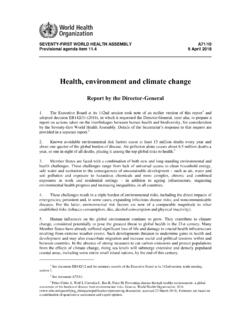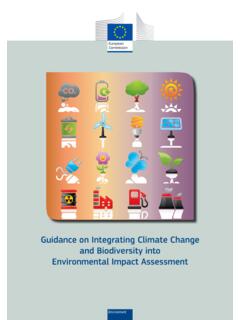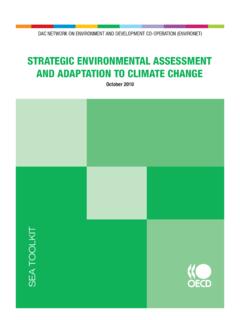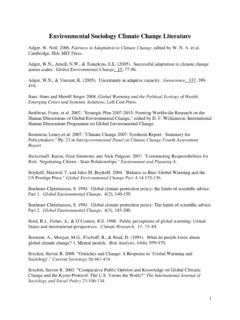Transcription of Prepared for By - United States Environmental Protection ...
1 climate change , INDOOR AIR QUALITY AND HEALTH Prepared for Environmental Protection Agency Office of Radiation and Indoor Air August 24, 2010 By Paula Schenck, MPH A. Karim Ahmed, PhD Anne Bracker, MPH, CIH Robert DeBernardo, MD, MBA, MPH Section of Occupational and Environmental Medicine Center for Indoor Environments and Health P climate change , Indoor Air Quality and Health By Paula Schenck, MPH A. Karim Ahmed, PhD Anne Bracker, MPH CIH Robert DeBernardo MD MBA MPH University of Connecticut Health Center Section of Occupational and Environmental Medicine Center for Indoor Environments and Health 1. Introduction and problem statement ..1 Background ..1 2. climate change and health as relates to indoor environment.
2 3 National Institute of Environmental Health Science 2010 report ..3 3. Environment and agents of concern in the indoor environment ..4 Temperature ..4 Outdoor air contaminants and indoor air quality ..4 Components of indoor air, links with adaptation measures and climate change ..4 4. Green buildings , indoor air quality and health ..10 Energy policy and regulation ..10 Green building, definition and attributes ..10 Buildings and illness ..12 Green building certification ..12 Weatherization and retrofit construction ..13 Available 5. Recommendations and outlook on public health and health provider roles ..15 Green buildings and public health Surveillance, sentinel case model and prevention.
3 16 Health information technology ..17 Access to sensitive and vulnerable groups through community health Clinicians public health leadership ..18 6. 7. Appendix A: Trainings for professional communities on buildings and health ..27 This manuscript was developed for the Environmental Protection Agency (EPA), Office of Radiation and Indoor Air, Indoor Environments Division. This report presents the findings, recommendations and views of its authors and not necessarily those of the Environmental Protection Agency. 11. Introduction and problem statement In the United States , Americans spend an estimated 90% (EPA 2009) - 92% (Bernstein et al. 2008) of their time in indoor environments. The quality of our indoor environments is a key determinant to the quality of life and health.
4 With climate change , attention to building quality has increased as the indoors is expected to become more of a refuge against heat and climate events. Improving building quality also offers an opportunity for more efficient use of energy. In the United States , estimates of proportional energy use attributed to buildings range from % (EPA 2009) to 48% (Architect 2030, 2010). Furthermore within 30 years, the majority (up to three-quarters) of our built environment is projected to be replaced with new and renovated construction (Architect 2030, 2010). There is a clear imperative for designing energy efficiency into building operations. How we construct and change these indoor environments to accomplish this imperative has the potential to contribute to or possibly subtract from the overall well-being of those who live, work or go to school in these indoor spaces.
5 Background The anthropogenic contributions to climate change will be a subject of continuing inquiry. However, the current national dialogue around climate change has shifted from mainly a debate about the phenomena and projections of impact to a discussion of actions to reduce green house gas emissions and mitigate atmospheric/global warming, and measures to adapt to likely global warming consequences. This shift coincided with national policy for economic stimulus, creating a focus and allocating resources for green programs. These actions provide an opportunity to substantially improve the quality of indoor environments and to advance public health. But it is critical to fully recognize the complex relationships among 1) indoor Environmental quality, 2) energy efficiency, 3) Environmental sustainability and 4) human health.
6 Without an in-depth appreciation of the interwoven nature of these relationships and definite actions to integrate all four elements into planning, there is likelihood for adverse effects to the quality of our indoor environments and associated threats to health, especially to the most at health risk populations. The public health and clinical communities share responsibility to serve the health needs of the population, especially the young, the old, the immune compromised, and the socio-economically disadvantaged. As programs are developing health professionals will need to work with Environmental experts to craft a national response to climate change . This response should: 1) prepare for anticipated health consequences from climate change by identifying programs designed to prevent and/or minimize outcomes; and 2) recognize the potential for and propose measures to avoid unintended health risks that may be coincident with energy efficiency measures.
7 However leadership in the Environmental , energy, public health and health provider communities will need to be nurtured and educated on the complex inter-connectedness among energy efficient actions, Environmental sustainable materials and occupant health. With recognition that developing policy and new resources will affect indoor environments and the potential for public health benefit, the Center for Indoor Environments and Health at the University of Connecticut Health Center (UCHC) assembled a team to 2 identify some aspects of climate change and adaptive measures that would likely affect indoor air quality and the health of occupants. Paula Schenck, MPH (Assistant Director, Center for Indoor Environments and Health (CIEH)) is the primary author.
8 A. Karim Ahmed, (Director, International Programs, National Council for Science and the Environment and Adjunct Professor, Occupational & Environmental Medicine, UCHC) contributed to the discussion of sources and provided insight into the science underlying climate change mitigation and adaptive measures. Anne Bracker, MPH CIH (senior industrial hygienist, CIEH) provided a focus on the unique vulnerabilities of our workforce and identified critical needs for training. Robert DeBernardo, MD MBA, MPH (an allergist affiliated with the CIEH) contributed to the discussion on surveillance and prevention. Martin Cherniack, MD MPH (Director of Occupational and Environmental Medicine Center, UCHC) guided the authors on role of health providers and provided a comprehensive internal review.
9 Paul Schur, MPH (Director of Environmental Health, retired State of Connecticut) and Paul A. Weinberger, MS (with expertise in energy and Environmental technology) provided independent reviews and contributed suggestions to the final paper. This manuscript has six subsequent sections. The first briefly identifies the current consensus on climate change and health as it relates to indoor air quality and diseases of most concern. The next section summarizes the agents of concern to human health in the indoor environment and the potential impact from adaptive building measures to global warming. The next segment describes green building programs, suggests an expanded definition and identifies questions that need to be resolved in order to make current certification processes effective for indoor air quality.
10 The fifth section discusses Environmental public health and healthcare community involvement and leadership with specific recommendations to address indoor environment. After a brief concluding section and list of references, a chart summarizing key components of trainings for professional communities with tasks that impact on buildings and health is presented in Appendix A. 32. climate change and health as relates to indoor environment Consensus scientific groups have concluded that climate change will affect human health (Confalonieri et al. / IPCC 2007, US Global change Research Program 2009, NIEHS 2010). Identified agents of concern include overall heat, ultraviolet penetration, biological materials such as pollens, molds and infectious agents, and air pollutants, especially ozone and particulate matter.



















